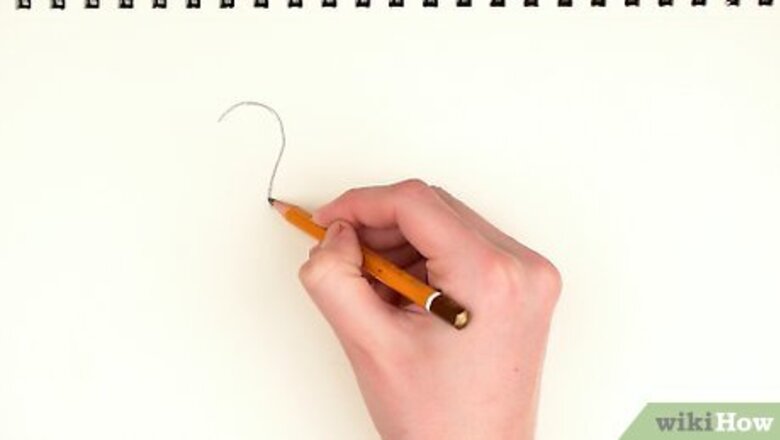
views
American Pekin Duck
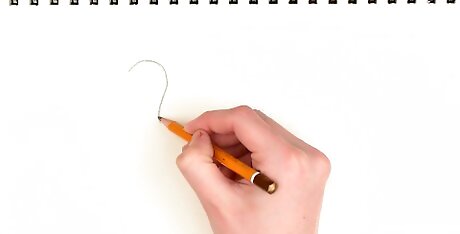
Draw the upper part of a question mark to make the duck’s head. Starting on the left side of your paper, use your pencil or marker to make a shape that looks like the upper part of a question mark. This will be the duck’s head and part of its neck. If you’re drawing on paper, turn the paper in a landscape direction so you have more room to draw.
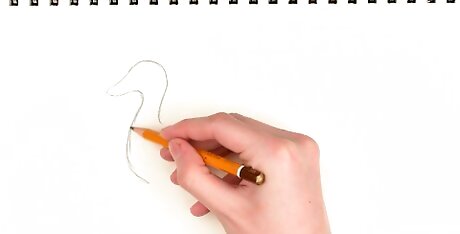
Make a point on the end, then drag the line down the neck. It’s time to give your duck a beak! On the front part of the question mark line you drew, draw a line going inwards slightly and then down. You’ll start to see the shape of a duck’s head and neck forming after this step. It won’t look very detailed yet, but don’t worry, you’ll add a lot more features to your duck before it’s done!
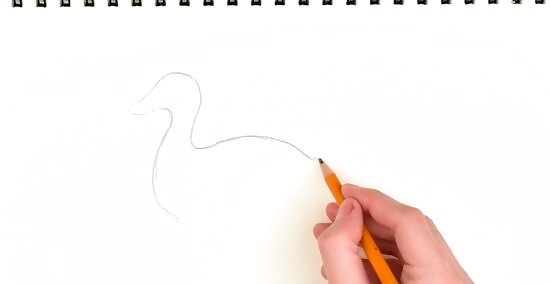
Add a body by drawing a curved line from the neck backwards. Think of how a duck looks when they’re sitting down. Take your pen or pencil and start from the bottom of the duck’s neck, then draw a line with a curve in the middle (for the duck’s back). When you reach the edge of the page, curve your line up just a little bit to add a tail. Duck bodies are usually about 3 times the size of their heads.
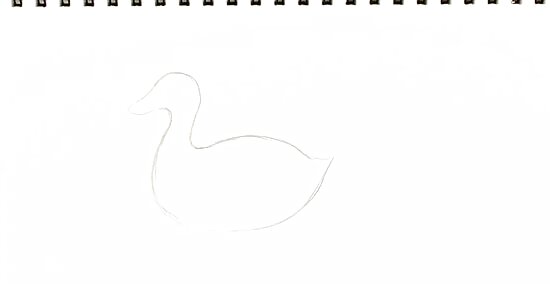
Complete the body with another curved line. Take your drawing instrument and drag it from the tail all the way to the front of the duck’s neck. Make this line curved too so your duck has a round body. When you get to the duck’s neck, connect the lines to complete the outline of your duck. It’s easiest to draw the duck sitting in water, especially if you’re just starting out. That way, you can avoid drawing the feet (which can be a little tough).
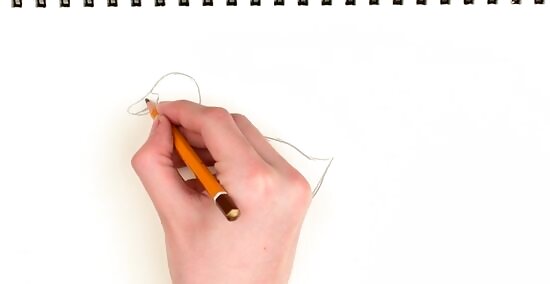
Draw the details of the beak. Now that you have the outline of your duck, you can start to add some details. Grab your pen or pencil and bring it up to the beak area of the duck, then make a curved line with a sharp point in the middle to mark the top of the beak. Add a straight line down the lower half of the beak to mark out the opening, then draw a small dot in the upper corner to signify the nostril. Duck beaks are slightly curved to account for the shape of their heads.
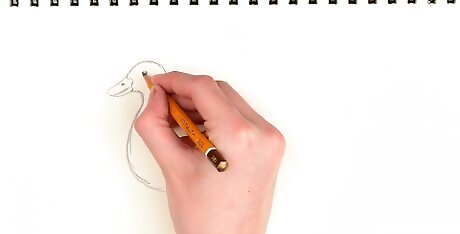
Color in a circle to make the duck’s eye. In the upper part of the duck’s head, draw a small round circle. Color in the bottom portion of the eye, but leave the top half blank so it looks like a bit of sunlight is bouncing off your duck. Leaving part of the eye uncolored is an easy trick to make your drawings look more professional.
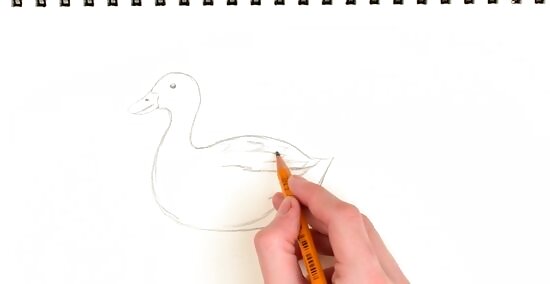
Draw some swooping feather details. Give your duck a wing by drawing a curved line from the front of the body to the back of the body, then add some smaller swoops on top for the feathers. If you want to add a more detailed tail, add 2 to 3 lines on the back of the duck’s body for some cute, pointed feathers. You can erase any outline of the duck’s body underneath the tail if you used a pencil.
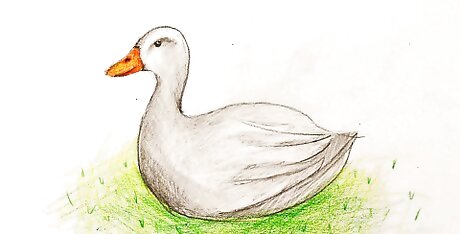
Color the duck white and the beak yellow. If you want to give a colorful pop to your duck, use a white colored pencil or crayon to fill in the body. Then, use yellow for the beak for a nice contrast. Now you’ve got an American Pekin duck to decorate your walls.
Female Duck
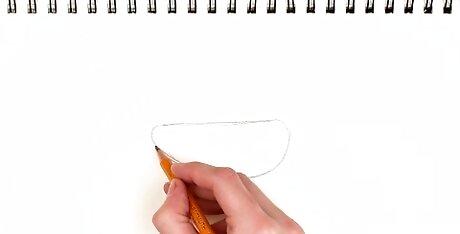
Draw the wing by making a half-circle. Start by drawing a straight line in the center of the page. Underneath that line, make a curved half-circle with the front part a little rounder than the back part. This will be your duck’s wing from the side. Keep your duck in proportion to the size of the wing. Usually, the wing is about half the size of the whole body.
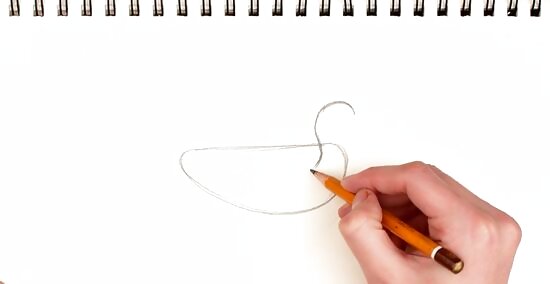
Make the outline of the head with a curved line. From the front of the wing (the more curved part), draw a curling line that goes up and over, kind of like the top part of a question mark. This will be the duck’s head and neck, so try to make it proportional to the wing you already drew. Ducks have pretty big heads in proportion to their bodies.
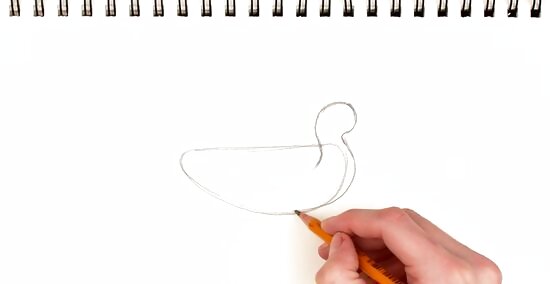
Finish the neck and add a tail. Drag a line down from the bottom of the duck’s head until it reaches the bottom part of the wing. Then, make a curved line on the back of the wing with a small tail pointing upwards. Duck tails are pretty small, so keep it tiny!
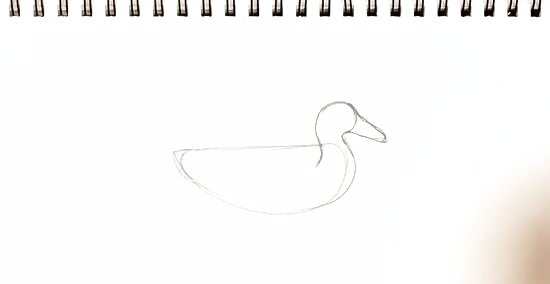
Add a beak on the front of the head. Make a curved line with a sharp point in the center on the front of the duck’s head. Then, make a “V” shape extending outwards to form the beak. Draw a line down the center of the beak to make an opening, then add a small dot near the top part to draw a nostril. You’re drawing a duck in side profile, so the beak should stick straight out.
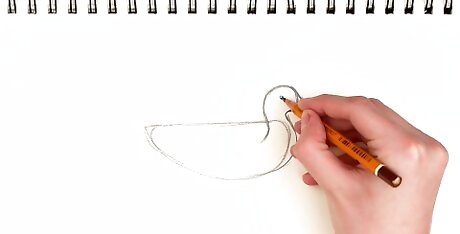
Draw an eye on the side of the duck’s head. For the finishing touch, give your duck a small eye by drawing a circle on the side of its head. Fill in the eye with black except for the top portion to signify the light shining against the duck’s head. Ducks have pretty small eyes, but you can make yours a bit larger if you want to up the cuteness factor.
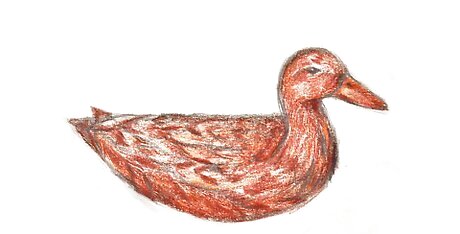
Color your duck in with browns and blacks. Female ducks have more muted colors, meaning they’re often brown, black, or gray colored. If you’d like to give your duck a pop of color, use brown as the initial shade and then add some black specks. Now you have a cute female duck swimming in the water. You can also add some blue waves to show that your duck is swimming or add a sun shining in the sky.
Mallard Drake
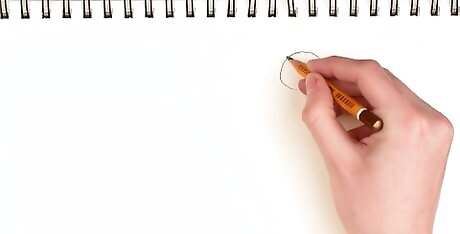
Draw a circle for the head and add a pointed beak. In the upper corner of the page, draw a small circle to create your duck’s head. Make a “V” shape sticking out of the circle that’s pointing to the side and slightly downwards; this will be the duck’s beak. Sometimes, it’s easiest to start with the head so you can make the body proportionate.
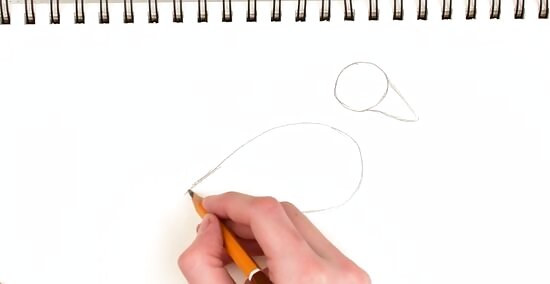
Make a teardrop shape for the body. Underneath the head and slightly to the right, draw a large teardrop shape with the point facing sideways and slightly downwards. The body should be pretty large in comparison to the head, so don’t be afraid to go bigger than you think.
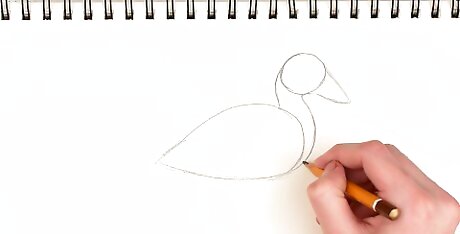
Connect the head and the body with the neck. Draw 2 swooping lines from the sides of the head down to the body. Duck necks aren’t entirely straight, so give yours some depth by adding a slight curve as the lines go down. When you’re finished, draw a stripe in the middle of the duck’s neck by making 2 horizontal lines (one on top of the other). Duck necks usually curve slightly outwards as they reach the body. Mallards usually have a white stripe differentiating their head from the rest of their neck.
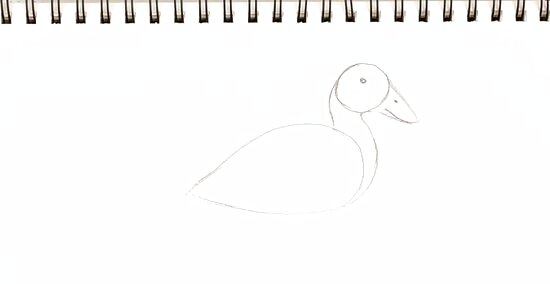
Draw the eye and the details of the beak. In the upper part of the duck’s head, make a small circle to signify the duck’s eye. Then, draw a swooping line with a point in the center to mark the start of the duck’s beak. Add a line going down the center of the beak to show that it opens and closes, then draw a small dot for a nostril on the beak as well. You can fill the eye in now or you can wait until later.
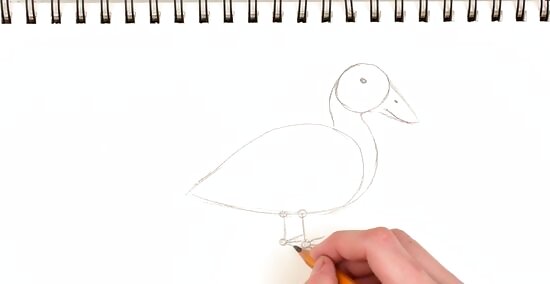
Add the outlines of the feet with basic lines and circles. Start the duck’s feet by drawing 2 straight lines going down from the bottom of the duck’s body. Add small circles at the bottom of the straight lines (for the duck’s ankles), then draw 3 more straight lines sticking out of those circles going slightly to the side (for the webbed feet). Duck feet can be challenging, which is why it’s important to do an outline first.
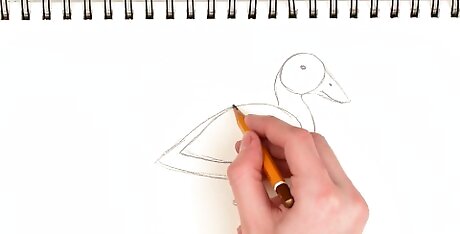
Make a wing on the top of the duck’s body. Starting from the bottom of the duck’s neck, draw a swooping line from left to right to make a wing on the upper part of the body. When you get to the end of the body, curve the line upwards in a point. Most mallards keep their wings held on the top portions of their bodies.
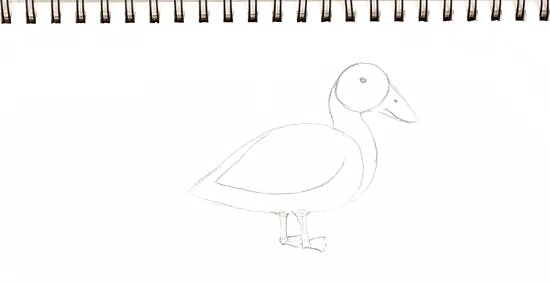
Outline the webbed feet. Take your pencil and outline the straight lines and circles you made for the duck feet. Go down from the body, then curve your line around to the toes to make an ankle. Draw the toes ending in a sharp point, then connect them with webbing for a classic duck foot look. Again: duck feet are tough! Don’t get discouraged if you have to try this part a few times. If all else fails, you can draw your duck sitting in a body of water with its feet hidden below the waves.
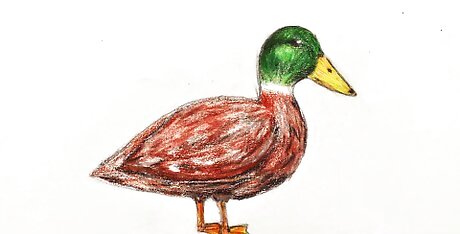
Color your duck with a green head and a brown body. One of the things that makes mallards so easy to spot is their classic coloring. Use a green colored pencil or marker to fill in the area above the stripe on the duck’s neck. Use a light brown for the body and the wing, and add yellow to the beak and the feet to finish it off. If you haven’t filled in the eye yet, do that with black or brown.
Duckling
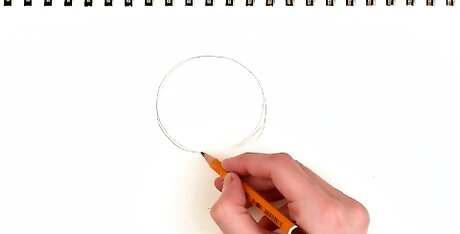
Make a large circle for the ducklings head. At the top of your page, sketch out a large, round circle to make the shape of your duckling’s head. Leave a small opening in the bottom of the circle so you can connect the body to the head later on. When you’re drawing a cute duckling, you don’t have to worry about making it too realistic, so you can go pretty large.
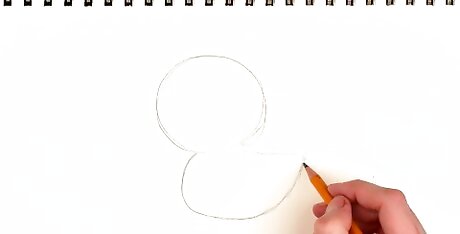
Draw a long, curved line from the head down to the side for the duck’s body. Starting from the left side of the duck’s head, make a swooping line to create the duck’s chest. Draw another line from the right side of the duck’s head to make the duck’s back, then connect the lines in a point for the duck’s tail. Duckling bodies are pretty small compared to their heads.
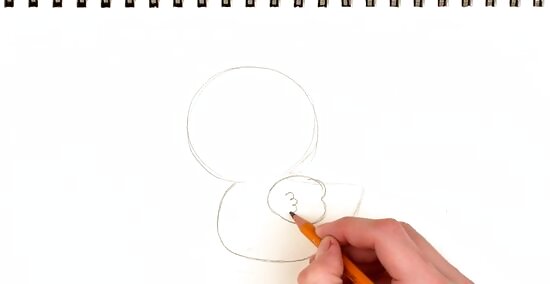
Make a small wing on the side of the duck’s body. For the top of the wing, draw a single curved line swooping from left to right. Make a half-circle on the bottom of the line, then add a bunch of swooping lines for some feathery details. Duckling wings are also pretty small in comparison to everything else since they’re still growing.
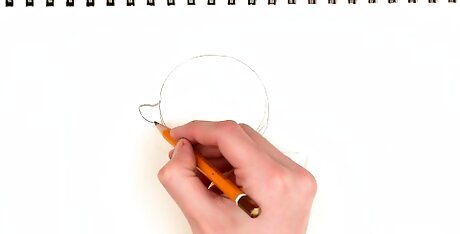
Add a pointed beak on the side of the duck’s head. Draw a “V” shape sticking out from the left side of the duck’s head, then draw a line down the middle to show that it opens and closes. Make a small dot on the top of the beak for the nostril.
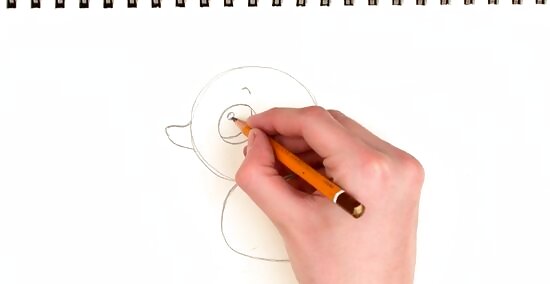
Sketch out a large eye in the center of the duck’s head. Draw a big, round circle in the middle of the duck’s head, like the duck is looking sideways. You can make this eye pretty large, especially if you’re going for a more cartoon-like duck than a realistic one. You can fill this eye in now with black, or you can save it for later.
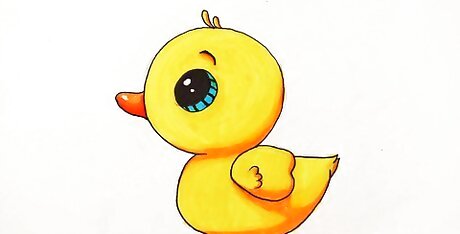
Fill the duck in with yellow. Most ducklings are yellow all over, so they don’t take a ton of time to color in. Grab a bright yellow colored pencil or marker and go to town on your duckling! If you haven't filled in the eye yet, give your duck a black pupil and a blue or brown iris. Try putting your baby duckling with a female duck to make a mother and child combo.
Pond of Ducks
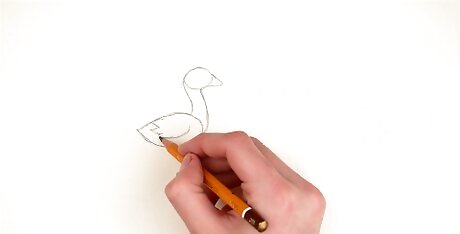
Sketch the body, head, and details of the mama duck. Start by drawing the biggest duck, or the female duck, in the center of the page. Make a large teardrop shape for the body, then connect a small circle to the body with the neck for the basic outline. Add a “V” shape for the beak, then put in a small wing on the top of the body. Remember, your duck will be sitting in water, so you don’t have to worry about the feet.
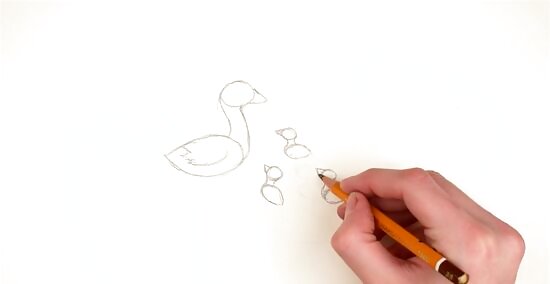
Add in 2 to 3 smaller ducklings. Keeping the mama duck size in mind, sketch out 2 to 3 smaller bodies of your ducklings surrounding the larger duck. Add their necks and heads as well, and give them a few feathery wings, too. Female ducks usually have a few ducklings surrounding them at all times.
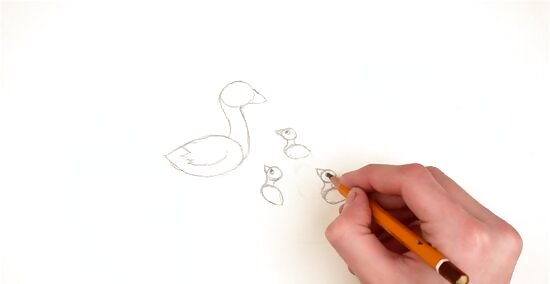
Make the ducks look at each other by giving them eyes. To give your ducks some personality, draw in some circles on the sides of their heads. If you really want to up the cuteness factor, make them all look at the mama duck so the babies have a cute connection with her. This will also make your audience feel more connected with the drawing (plus, it’s just adorable).
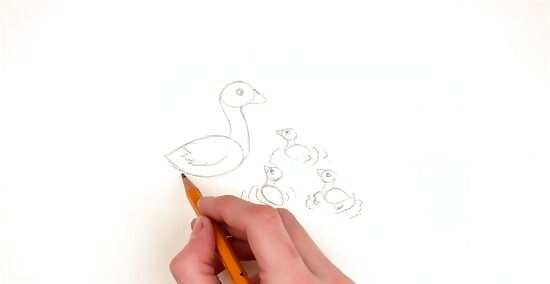
Draw some swooping waves beneath the ducks. Since your ducks are sitting in the water, it’s not going to look completely still. Right underneath each duck, draw some small, swooping lines (kind of like how you drew the feathers on each duck). If you want the waves to look more serene, draw small circles instead of waves.
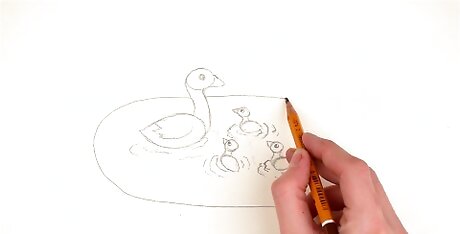
Add the outline of the pond. Draw a large circle around your ducks to add the borders of the pond that they’re sitting in. If you’d like to, you can add some grass fronds around the edges of the pond, too. The pond can fill up your entire page or just be a small part of it. It’s up to you!
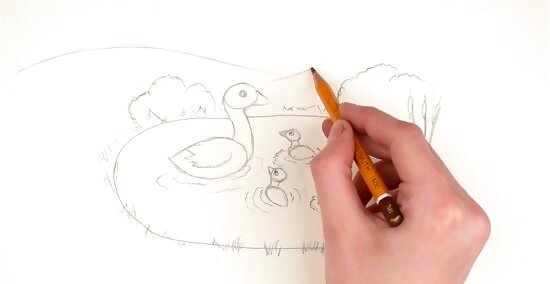
Draw a few trees or hills. In the background of your scene, add in some spiked trees by making sharp, jagged lines in a triangle shape. If you’d like to add some rolling hills or mountains, make a few half-circles in the background behind your pond to give the scene some depth. You can also add in some fluffy clouds, bright spring flowers, or hanging vines. This is your pond, so get creative with it!
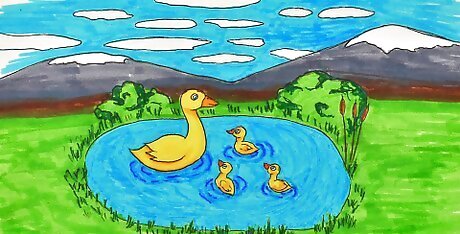
Color in your drawing to make it pop. Since your duck is female, stick to muted browns and grays for her body, but use yellow for the beak. You can use the same yellow on the ducklings, too. Add some blue to the pond water and fill in any plant life with green, then pick a lighter shade of blue for the sky. Now you can show off your duck pond to your friends and family!



















Comments
0 comment